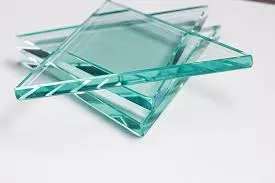Understanding Blue Float Glass A Versatile Architectural Element
Blue float glass is a unique and increasingly popular type of glass used in various architectural and design applications. Known for its aesthetic appeal and functionality, this specific type of float glass is characterized by its blue hue, which can vary in intensity depending on the manufacturing process and intended application. This article delves into the properties, production methods, uses, and advantages of blue float glass in the architectural world.
What is Float Glass?
Before exploring blue float glass, it's essential to understand the concept of float glass itself. Float glass is made by floating molten glass on top of molten tin, a process that creates a flat and smooth surface. This technique was developed in the 1950s and revolutionized the glass industry by providing high-quality sheets of glass suitable for various applications. The float glass process allows for precise thickness and uniformity, making it ideal for architectural needs.
The Production of Blue Float Glass
The production of blue float glass involves the same fundamental processes as standard float glass, with the added step of incorporating colorants during the melting stage. Cobalt and other metal oxides are typically used to achieve the blue tint. The depth of color can be adjusted based on the amount of colorant added, allowing manufacturers to create a range of shades from light sky blue to deep ocean blue. This coloration does not affect the fundamental properties of the glass, such as its strength and thermal resistance.
Aesthetic Appeal and Design Versatility
One of the most notable features of blue float glass is its visual appeal. The calming and serene blue tones can dramatically enhance the aesthetic of any space, whether commercial or residential. Architects and designers often opt for blue glass for facades, windows, and interior elements as it creates a striking contrast with other materials such as wood, metal, and concrete.
Moreover, blue float glass can be used in conjunction with other colors, allowing for dynamic designs that can fit various styles, from modern minimalism to classic elegance
. Its reflective properties can also create visually engaging environments, particularly when used in large formats that capture and reflect natural light.
Applications of Blue Float Glass
blue float glass
Blue float glass finds its application in several areas, including building facades, glass partitions, skylights, and window installations. Its ability to reduce glare while still allowing natural light to penetrate makes it an ideal choice for office buildings, shopping malls, and residential complexes.
Additionally, architects increasingly incorporate blue float glass into decorative elements such as doors, tabletops, and bathroom fixtures. This type of glass can be tempered or laminated to enhance its safety and durability, making it suitable for high-traffic areas where strength is paramount.
Advantages of Blue Float Glass
The benefits of blue float glass extend beyond its aesthetic qualities. Some key advantages include
1. Energy Efficiency Blue float glass can help improve energy efficiency by reducing solar heat gain while allowing adequate natural lighting.
2. UV Protection The blue coloration can offer a level of UV protection, helping to safeguard interiors from fading caused by sunlight.
3. Safety and Security When treated, blue float glass can be made shatter-resistant, increasing safety in various applications.
4. Sustainability Many manufacturers focus on sustainable practices, using recycled materials in the production of float glass, including its colored variants.
Conclusion
In summary, blue float glass represents a perfect fusion of beauty and functionality, making it a favored choice in modern architecture. Its appealing aesthetics, combined with outstanding physical properties, open up a plethora of design possibilities. As trends in architecture continue to evolve, blue float glass will likely remain a valuable material, enhancing both the beauty and performance of structures for years to come. Its intrinsic value lies not just in aesthetic enhancement but also in contributing to sustainable and energy-efficient building practices.
 Afrikaans
Afrikaans  Albanian
Albanian  Amharic
Amharic  Arabic
Arabic  Armenian
Armenian  Azerbaijani
Azerbaijani  Basque
Basque  Belarusian
Belarusian  Bengali
Bengali  Bosnian
Bosnian  Bulgarian
Bulgarian  Catalan
Catalan  Cebuano
Cebuano  Corsican
Corsican  Croatian
Croatian  Czech
Czech  Danish
Danish  Dutch
Dutch  English
English  Esperanto
Esperanto  Estonian
Estonian  Finnish
Finnish  French
French  Frisian
Frisian  Galician
Galician  Georgian
Georgian  German
German  Greek
Greek  Gujarati
Gujarati  Haitian Creole
Haitian Creole  hausa
hausa  hawaiian
hawaiian  Hebrew
Hebrew  Hindi
Hindi  Miao
Miao  Hungarian
Hungarian  Icelandic
Icelandic  igbo
igbo  Indonesian
Indonesian  irish
irish  Italian
Italian  Japanese
Japanese  Javanese
Javanese  Kannada
Kannada  kazakh
kazakh  Khmer
Khmer  Rwandese
Rwandese  Korean
Korean  Kurdish
Kurdish  Kyrgyz
Kyrgyz  Lao
Lao  Latin
Latin  Latvian
Latvian  Lithuanian
Lithuanian  Luxembourgish
Luxembourgish  Macedonian
Macedonian  Malgashi
Malgashi  Malay
Malay  Malayalam
Malayalam  Maltese
Maltese  Maori
Maori  Marathi
Marathi  Mongolian
Mongolian  Myanmar
Myanmar  Nepali
Nepali  Norwegian
Norwegian  Norwegian
Norwegian  Occitan
Occitan  Pashto
Pashto  Persian
Persian  Polish
Polish  Portuguese
Portuguese  Punjabi
Punjabi  Romanian
Romanian  Russian
Russian  Samoan
Samoan  Scottish Gaelic
Scottish Gaelic  Serbian
Serbian  Sesotho
Sesotho  Shona
Shona  Sindhi
Sindhi  Sinhala
Sinhala  Slovak
Slovak  Slovenian
Slovenian  Somali
Somali  Spanish
Spanish  Sundanese
Sundanese  Swahili
Swahili  Swedish
Swedish  Tagalog
Tagalog  Tajik
Tajik  Tamil
Tamil  Tatar
Tatar  Telugu
Telugu  Thai
Thai  Turkish
Turkish  Turkmen
Turkmen  Ukrainian
Ukrainian  Urdu
Urdu  Uighur
Uighur  Uzbek
Uzbek  Vietnamese
Vietnamese  Welsh
Welsh  Bantu
Bantu  Yiddish
Yiddish  Yoruba
Yoruba  Zulu
Zulu 

